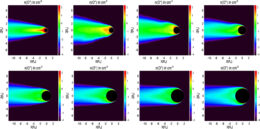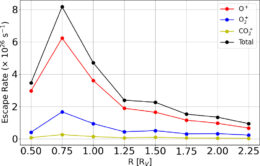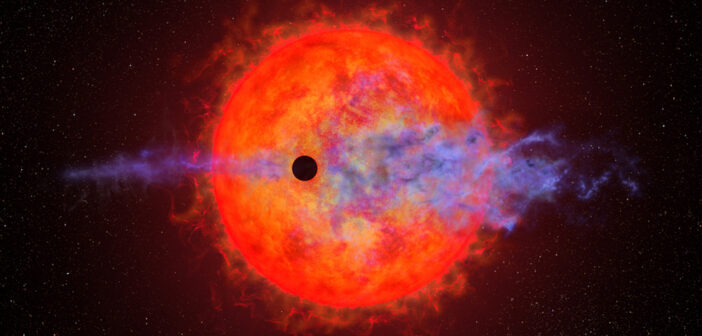Which planets are most likely to lose their atmospheres? New research finds a surprising relationship between planet size and atmospheric escape and suggests that the smallest planets aren’t losing their atmospheres the fastest.
The Role of Atmospheric Loss

An illustration of Mars losing ions from its atmosphere during a solar storm. [NASA/GSFC]
Other planets in distant star systems are not as lucky: pummeled by fierce radiation and howling stellar winds, many exoplanets will lose most or all of their atmospheres. A planet’s ability to hold on to its atmosphere shapes its habitability, the possibility of harboring long-lived oceans, and other critical factors. With exoplanet habitability a persistently hot topic in astronomy, it’s critical to know which planets are most likely to have atmospheres.
What’s Radius Got to Do with It?
To approach this question, a team led by Laura Chin (Boston University) investigated how a rocky exoplanet’s size affects its ability to hang on to its atmosphere. Using fluid dynamics models, Chin and collaborators simulated the atmospheric loss due to stellar radiation and stellar winds. High-energy radiation ionizes atmospheric particles, allowing them to be picked up and carried away by the magnetized stellar wind, and imparts enough energy to some particles to allow them to escape the planet’s gravitational pull.

Model output showing the escape of oxygen ions from planets of varying sizes. Click to enlarge. [Chin et al. 2024]
A Surprising Finding

Escape rate as a function of planetary radius for three types of ions (colored lines) and all atmospheric particles (black line). [Chin et al. 2024]
The increase in the escape rate for planets with radii from 0.5 to 0.75 RV appears to be driven by the increase in the planet’s size; a larger planet’s atmosphere absorbs more starlight (i.e., energy), creating more ions that can be stolen away by a magnetized stellar wind and boosting the escape rate. Above 0.75 RV, the decrease in the escape rate is driven by the increase in the planet’s gravitational pull, which makes it harder for atoms to depart the atmosphere.
This result contrasts with expectations that the atmospheric escape rate is largest for the smallest planets. Future surveys of rocky planets around M-dwarf stars may be able to search for a connection between planet size and atmosphere thickness, testing this finding.
Citation
“Role of Planetary Radius on Atmospheric Escape of Rocky Exoplanets,” Laura Chin et al 2024 ApJL 963 L20. doi:10.3847/2041-8213/ad27d8
